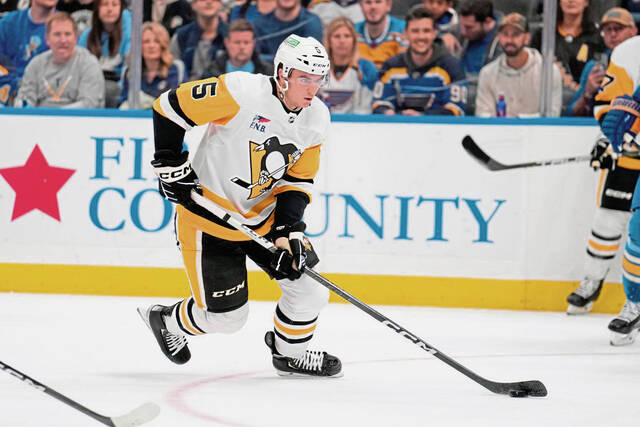https://development.triblive.com/sports/penguins-defenseman-ryan-shea-takes-nothing-for-granted/
Penguins defenseman Ryan Shea takes nothing for granted

The novelty of being in the NHL still hasn’t worn off for Pittsburgh Penguins defenseman Ryan Shea.
Considering how long it took him to get to the NHL, it likely won’t dissipate any time soon.
A fourth-round pick of the Chicago Blackhawks (No. 121 overall) in 2015, Shea never signed with that organization and opted to stay at Northeastern University for four years. Following his collegiate days, he signed with the Dallas Stars but spent all three of his seasons with that organization at the AHL level with the Texas Stars.
The Penguins signed him this past offseason, gave him every opportunity to earn a roster spot in training camp, and then plopped him right into their lineup for his NHL debut Oct. 21.
Being in the NHL is no small thing for Shea.
“I don’t know if it will ever wear off, to be honest,” Shea said Oct. 26 at PPG Paints Arena. “This is why I play. This is why I started when I was so young. This is why my dad and my support cast got me into this sport. I don’t think it will ever wear away until I’m done playing. You’ve got to appreciate every day you’re up here because it’s something special. It’s just a dream come true.”
That dream has manifested itself in the form of six games and no points while averaging 13 minutes, 58 seconds of ice time, primarily skating on the third pairing.
The left-handed Shea is one of four players the team has used on that bottom pairing this season, including fellow southpaws P.O Joseph and John Ludvig and right-hander Chad Ruhwedel.
Ludvig has been limited to a single game after he suffered a concussion during his NHL debut Oct. 24. Beyond that, there have been few limits to the combinations coach Mike Sullivan and staff have experimented with on the third pairing.
During a 10-2 road win against San Jose Sharks on Saturday, Shea opened the contest on the right side with Joseph as his partner.
“They all bring a little something different to the table,” Sullivan said. “It all depends on who’s playing well, which guys might be complementary to one another. For example, now, we’ve got a number of (left-handers), do guys have the ability to play the right side? Does that put them in a position to be successful? How we’re going to deploy them? Do we need penalty killers? Do we need power-play guys? Then part of the discussion, quite honestly, is our opponents and who might do better against certain opponents and what their strengths might be.”
Shea’s resolve appears to be mighty considering how long the 26-year-old waited to put his skates onto a rink for an NHL game of consequence.
(Note: Shea made his NHL debut so late in life, he is not officially considered a rookie because of the NHL’s rules that declare players who are 26 by Sept. 15 of that season not eligible to be considered rookies. Shea turned 26 on Feb. 11.
This is colloquially known as the “Makarov Rule,” which came into existence after Calgary Flames forward Sergei Makarov won the Calder Memorial Trophy as the NHL’s top rookie at the age of 32 in 1990.)
“He’s really happy to be here,” said Ruhwedel, who has been Shea’s most common partner this season. “He should be here. There’s no doubt about it. When you see that kind of happiness around the locker room and excitement, it’s contagious.”
Shea doesn’t need to look far to find a good role model when it comes to navigating a lengthy journey to the NHL and finding a way to stay there.
He just has to look to his right on occasion.
Undrafted, Ruhwedel spent three seasons at the NCAA level with Massachusetts-Lowell then languished in the Buffalo Sabres’ system for four seasons before joining the Penguins in 2016 and finding a steady role.
“I talk to (Ruhwedel) a bunch,” Shea said. “He’s probably one of the guys at the top of the list that helped me the most. He just talks. He explains the game on the bench (or) in practice. He’s kind of a physical freak. His work ethic in the gym … that’s kind of what I want to be. Just try to get better every day like he does.”
Being in the lineup on any given day is hardly a guarantee for Shea. He fully realizes that given his experience as a professional.
He also realizes what he needs to do in order to stay on the ice while competing with Joseph, Ludvig and Ruhwedel.
“We all play better under the pressure,” Shea said. “We know what we have to do. Whether it’s 10 minutes or 15 minutes, we don’t want to get scored on, we want to move pucks up quick to our forwards and join the rush when we can. Our leash is a little bit shorter. We’ve got to earn that. Some guys can do a lot more. We’re just trying to play our role and (help) this team win.”
Follow the Penguins all season long.
Copyright ©2025— Trib Total Media, LLC (TribLIVE.com)
